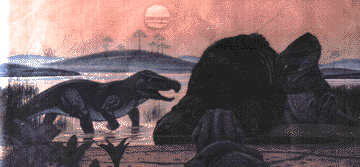
| Palaeos: Mesozoic |  |
Early Triassic |
| Triassic PERIOD | Early Triassic |
| Page Back | Back: Lopingian | Back: Permian | Up: Triassic | Unit Home |
| Page Next | Next: Middle Triassic | Next: Jurassic | Down: Induan | Timescale |
| Paleozoic Permian Lopingian Mesozoic Triassic Early Triassic Induan Olenekian Middle Triassic Late Triassic Jurassic Cretaceous |
Stratigraphy Early Terrestrial Biotas
|
 image courtesy of Mathematical Com
|
| The later Early Triassic (Olenekian age) Archosauriform Garjainia, a member of the family Eyrthosuchidae. These large animals, which reached 3 meters and more in length, were the first big predators of the Mesozoic era. |
The Early Triassic period is also known as the Scythian epoch. The following table shows the Scythian epoch's main subdivisions. Because this stage of Earth history did not last very long, we are only considering it in terms of its two main subdivisions, the Induan and the Olenekian. Nevertheless, this was a period of great change and drama, as whole new lineages and clades of animals radiated into the empty niches vacated by the Permian fauna, and the evolutionary battle for the supremacy of the land was waged. The hot dry Pangean deserts of the Triassic would witness the competition between the synapsid proto-mammals (therapsida) that had dominated the land uptil now, and the newly emerged archosaurian reptiles (thecodonts). And in the arid climes of the early Mesozoic, the reptiles had an obvious metabolic advantage, despite the superior locomation and care of young behavior of the mammals. MAK
| Early Triassic (Scythian) |
Olenekian | Spathian |
|
| Nammalian | Smithian | ||
|
Induan (=Brahmanian) |
Dienerian (=Gandarian) |
||
Griesbachian (= Gangetian) |
|||
Early Triassic marine biotas were seriously impoverished. Recovery from the extinctions at the end of the Permian was slow for many groups. Many types of corals, brachiopods, molluscs, echinoderms, and other invertebrates had disappeared altogether, and many survivors remained hidden (possibly in geographically restricted environments) before returning as "lazurus taxa" during the middle or late Triassic.
With the extinction of many typically Paleozoic faunas, the most common Early Triassic hard-shelled marine invertebrates were bivalves, gastropods, ammonoids, echinoids, and a few articulate brachiopods. This mix of invertebrates constitutes the Modern Evolutionary fauna, even though most of these forms were also present in the Paleozoic Evolutionary Fauna. However, other typically Palaeozoic forms like Strophomenid Brachhiopods, Trilobites, Blastoids, and many type of Crinoids are gone.
On land, the period that followed the great Permian extinction was also an important time. The increasing aridity further contributed to the ascendency of the seed-bearing Gymnosperms over the spore-bearing plants.
As for the tetrapods, the few surviving reptiles became the ancestors of all later Mesozoic animals. The most common and widespead animal, Lystrosaurus, was a medium-sized herbivore, a dicynodont, a distant relative of the mammals. The only other large animals were the labyrinthodont (temnospondyl) amphibians and the semi-aquatic Proterosuchus, the latter in size, appearance, and habits, probably resembling a small (1.5 meter) unarmoured crocodile. We are used to thinking of prehistoric animals as all giant-sized - the great brontosaurus and tyrannosaurus of the Mesozoic for example; or the giant mammals of the last age (the Pleistocene). But at this particular period in the Earth's history all the animals were only moderately sized. Such a "Lilliput Effect" (which concerned both invertebrates [Price-Lloyd and Twitchett 2002] and veretbrates, may be the logical result of a big extinction event. Several million years further on in the Early Triassic, larger animals did appear; Lystrosaurus was replaced by the ox-sized Kannemeyeria, and large carnivores such as wolf-sized therapsid Cynognathus and the large archosaurs Garjainia (see illustration above) and Erythrosuchus also made their appearance. They were accompanied by many smaller animals, whilst many of the Permian hold-overs like the carnivorous Moschorhinids dissappeared (only teh lizard like Procolophonids flourished). These reptiles were the largest animals of their day (Erythrosuchus had a skull alone a meter in length), and were not surpassed in size until the rise of the bigger dinosaurs near the end of the Triassic.
These terrestrial animals were accompanied by various types of large temnospondyl amphibians belonging to the Capitosaur clade. In fact, the capitosaurs were to dominate the freshwater ecosystems for much of the Triassic. MAK
| Page Back | Unit Home | Page Up | Page Top | Page Next |